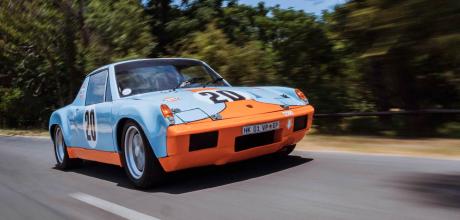Restomod Gulf-liveried 1970 Porsche 914/6 with a 2.4-litre flat-six
Created by a Porsche-loving family with their love of the 917 and Steve McQueen’s Le Mans movie in mind, this eye-popping 914 makes use of a 2.4-litre oversized flat-six and is set to take on South Africa’s Targa road rallies...
Words Johann Venter
Photography Douglas Abbot
914 RESTOMOD — SALUTE THE COLOURS
A Gulf-liveried 1970 Porsche 914/6 with a 2.4-litre flat-six
Imagine being able to order a Gulf-liveried 914 in the 1970s. This is exactly the thought process serving as the catalyst for the Targa-topped air-cooled roadster you see on these pages. The work of Tim and Douglas Abbot, the project took on a life of its own when additional inspiration was provided by the two 918 Spyders finished in Gulf colours by the Porsche factory. Whether wrapped or painted, we suspect there are a number of 918s dressed in the iconic blue and orange branding, but Zuffenhausen only produced two, albeit at customer request. We have Vaughn Wyant to thank — he owns the Saskatoon Porsche dealership in Saskatchewan, Canada, and was hell-bent on getting his way.
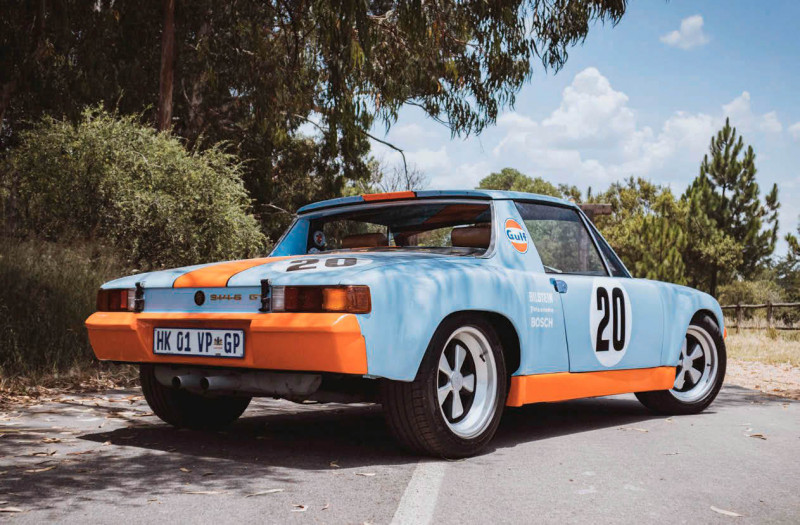
His powers of persuasion worked, first by convincing Gulf to let him use its branding, and then by charming the suits in Stuttgart. Tim and Douglas took note, but why did they choose to apply Gulf paint and body graphics to a 914? Let’s take a few moments to understand who the Abbots are before we delve deeper.
DEAD AHEAD IS THE INSTRUMENT BINNACLE, THE REV COUNTER SHOWING 10,000RPM AND THE SPEEDO REACHING 300KM/H
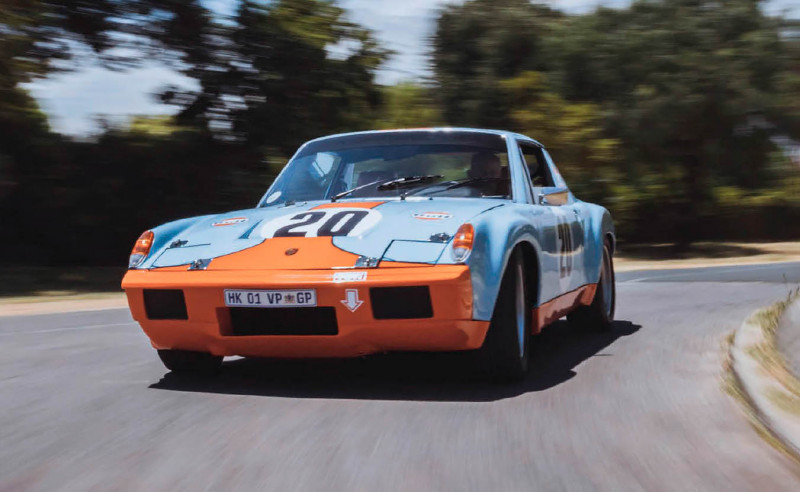
Abbot Cars is one of the foremost independent classic Porsche specialists in South Africa, founded close to fifty years ago by Tim’s father, John Abbot. The company’s workshop — situated a stone’s throw from the legendary Kyalami race circuit — is where they maintain and restore air-cooled classics. The business has seen successive generations of the Abbot clan come into service, with Jen, Tim’s daughter, becoming an integral part of the mechanical team, and his son, Douglas, focused on marketing. Tim has always been keen on 914s, more so after having restored a 1970 1.7-litre example in the mid-1980s, a car which won its class and was declared overall winner at a Porsche Club Concours event. An altogether different Porsche, however, left a more indelible mark.
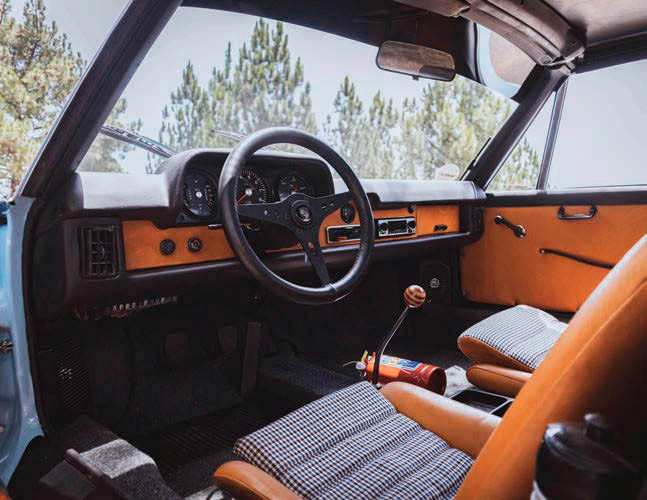
In November 1970, when Tim was ten years old, his father took him to the year’s nine-hour endurance race at Kyalami. Abbot the Younger was mesmerised by the luminous yellow and red 917 short-tail piloted by Jo Siffert and Kurt Ahrens. The Porsche pairing could only achieve a second-place finish on the day (beaten to the top spot by the Ferrari 512 M driven by Jacky Ickx and Ignazio Giunti), but instilled in Tim a passion for the brand and a fascination for the 917 in particular. Fast-forward to the 2008 Le Mans Classic. While Tim was enjoying seeing cars from his youth duke it out on track, he had a Eureka moment about the 914 he’d bought three years prior — he reasoned he could turn his project Porsche into a Marathon de la Route replica and enter it at the next Le Mans Classic. Marathon de la Route, an eighty-six-hour epic staged between 1965 and 1971 is to this day considered one of the most arduous and gruelling races ever contested, navigating the north and south Loops of the Nürburgring for three and a half days straight. In 1970, Porsche entered three works 914/6 GTs into the competition, hot on the heels of a highly successful Le Mans campaign, where the 914/6 GT had trounced all 911s in the field and finished just five places behind the winning 917, taking the GT class in the process. Car number one of the Marathon de la Route 914/6 GT trio was driven by Claude Haldi, Gérard Larrousse and Helmut Mark. It won after circumnavigating the Nürburgring 360 times, covering a massive distance of 10,184km. Car number three followed close behind, raced by Åke Andersson, Guy Chasseuil and Björn Waldegård. Car number three, raced by Claude Ballot-Léna, Nicolas Koob, and Günter Steckkönig, locked out the podium.
THE LOW CENTRE OF GRAVITY, PLUS THE MID-ENGINE LAYOUT, ALLOWS FOR TIGHT TURN-IN THROUGH BENDS
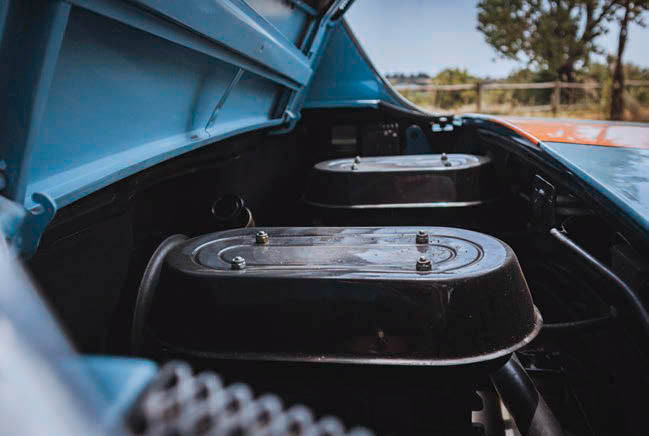
Regulations governing Tim’s 914/6 GT Marathon de la Route tribute entering the Le Mans Classic proved to be extremely stringent. The car had to be built as close to original FIA specification as possible. And, as a tribute, the car would only be accepted if none of the original Marathon de la Route 914/6 GTs were entered. Even with the assistance of Red Bull F1 team boss, Christian Horner, summoned by Tim’s brother, Anthony, who was working under Horner as head of Red Bull’s engineering software division, the Abbot team failed to make it to the grid. The Abbots did, however, find a local endurance race with which to put their punchy 914 through its paces — on the 5th December 2009, they entered the Kyalami 9-Hour Retro, comprising a series of sprint races and the three-hour Springbok Series endurance race.
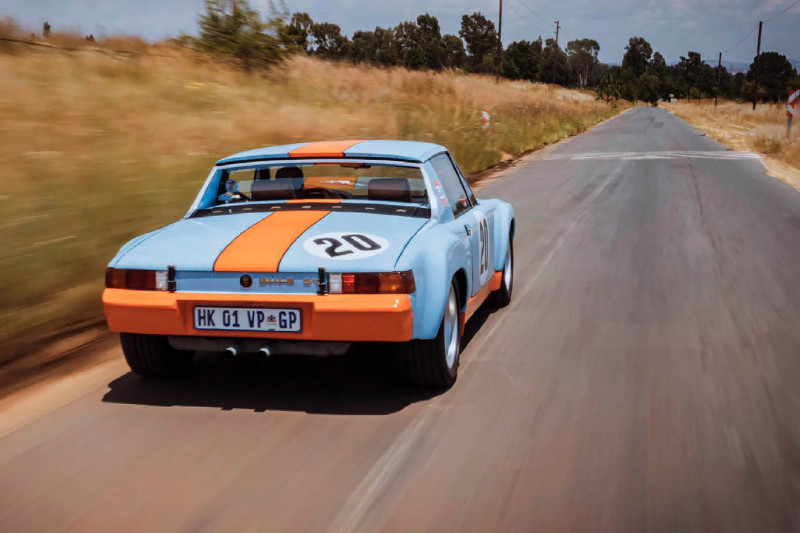
For the Springbok event, the 914’s driver line-up consisted of Tim and Anthony, while the pit crew was made up of Douglas, then thirteen, and Jen, aged just eleven. An old army mate of Tim’s from Cape Town led the charge as crew chief. Team Abbot managed to clinch their class on index, largely thanks to making far fewer pit stops than rivals, such is the fuel efficiency of a 914 built to GT specification. This wasn’t end of the Abbot’s 914 story, though. In 2018, they acquired a completely unscathed 1.7-litre model, bought new in Milan in 1972. When the owner immigrated to South Africa, he brought the 914 with him. It changed hands in 1998 and, for the following two decades, was cherished by Bobby Lange, one of the eleven founding members of Porsche Club South Africa, established some thirty years earlier.
TEAM ABBOT MANAGED TO CLINCH THEIR CLASS ON INDEX, LARGELY THANKS TO MAKING FAR FEWER PIT STOPS THAN RIVALS
This brings us to the 914 you see on these pages, adorned in one of the world’s most recognisable racing liveries, which came about in 1967, when Ford dramatically scaled down its Ford Advanced Vehicles (FAV) and GT40 operations. John Wyer and John Willment effectively took over, forming JW Automotive Engineering (JWA). Grady Davis, a senior executive at Gulf and a man who owned his own racing GT40, saw potential in the newly formed JWA, and threw the weight of Gulf Oil behind the team. At the time, Gulf colours were orange and dark blue, but Davis was convinced a paler blue suited the shape and contours of the GT40 much better.
He was onto something — the combination of these two colours results in a phenomenon known as equiluminant, where outlines are blurred, giving the suggestion of motion. Interestingly, Gulf would go on to become the first oil company in history to trademark its racing colours, Zenith Blue (3707) and Tangerine (3957).
Whilst admiring the Gulf-dressed 914/6 GT evocation at the Abbot workshop on the Beaulieu Country Estate, I’m flanked by Tim and Douglas. How did this 917-aping 914/6 GT come about? “I imagined Porsche coming to us in the 1970s and giving us a brief to design a 914 to invigorate sales. In 1970, there was much to celebrate, not least the 914/6 GT taking a hat-trick at the Marathon de la Route and coming sixth overall at Le Mans,” Douglas smiles. “That same year, the 914 became Motor Trend’s first Import Car of the Year and, in 1971, Steve McQueen’s epic motoring move, Le Mans, was released, rewriting the outcome of the 1970 race by depicting Gulf 917s taking first and second place, further increasing Porsche’s cache and that of Gulf Oil. Taking all of this into account and being inspirited by what Vaughn Wyant did with his 918s, we came up with the concept for the 914 you see here. Without question, the only way to go was with the most recognised racing livery of the 1970s, but we also wanted to incorporate aspects of the 917, the most obvious nod being our 914’s front air-scoop.”
Tim steps in to add further clarification. “I’ve always loved Le Mans. I went to see it at the cinema on release and bought it as soon as it was released on VHS in the 1980s. To quote Jackie Stewart, it depicted an era of racing when sex was safe and motor racing was dangerous. With Steve McQueen’s character, Michael Delaney, in mind, I was excited about the idea of incorporating aspects of the film’s Gulf 917s into our 914 build.”
Le Mans wasn’t a box office success when it was released. It almost ruined Steve McQueen, ended his production company, his marriage and plenty of friendships. Worse still, endurance racer, David Piper, was involved in an accident during shooting and had to have his right leg amputated below the knee. Today, of course, Le Mans is a cult classic and anything associated with it has turned to gold.
917-024, for example, the short-tail 917 starring as the movie’s race winner, sold at the 2017 Gooding & Company sale at Pebble Beach for $14,080,000, setting a new record for the Porsche marque. Incidentally, this same chassis was used for testing by JWA at Le Mans in 1970, but didn’t participate in the race.
At the 2021 RM Sotheby’s auction held at Monterey Car Week, chassis 917-026 was listed with an estimate of between $16,000,000 and $18,500,000. This car was campaigned at Le Mans in 1970 by Mike Hailwood and David Hobbs under the number twentytwo, but Hailwood spun in the wet at the Dunlop Curve on lap forty-nine, hitting a stationary Alfa Romeo T33/3, ending the Porsche’s race. Beforehand, however, this car was filmed in action by Steve McQueen’s 908/2, entered into the event for the purposes of capturing rolling shots for the Le Mans flick. 917-026 didn’t sell at the RM Sotheby’s sale, but came close, with the highest bid reaching $15,000,000.
We digress. Tim had the concept, but he needed to bring it to fruition. “Ten years ago, I was offered a pair of 914s I simply could not refuse. The 1972 914 1.7 formed the basis for this car, while the second 914 was a badly rusted 1970 1.7. We managed to salvage the latter’s trailing arms, some other suspension parts, plus the gearbox linkages. Items we could make use of made their way into the Gulf build, the rest went into our workshop parts bin. From the get-go, though, I knew we’d build a 914/6 GT tribute. I didn’t see the merit in restoring a non-matching numbers 914 1.7.”
Considering he already owns a 914/6 GT tribute (the Marathon de la Route car talked about earlier), how would the Gulf project be different? “In 2019, Abbot Cars entered the 1,100km Targa Ramponi in Mpumalanga, the most eastern province in South Africa. The event is named after Giulio Ramponi, a famous Italian pre-war mechanic-come-racer who settled in South Africa when he retired in 1968.
During the race, in which we’d entered a couple of 911s, it dawned on me the 914 we were busy building would be ideal for these Targa driving excursions. Our Marathon de la Route tribute was developed for participating in historic racing. For Targa events, I wanted something more comfortable we could enjoy through sweeping mountain passes.”
We ask him to talk us through the transformation. “We took inspiration from the M471 package Porsche offered for the 914 in early 1971. This resulted in a roadlegal GT. Only twenty-three examples were assembled. These 914s came with a flat-six, flared wheel arches and wider Fuchs wheels, as we’ve replicated. Anton Dekker, proprietor of Exclusive Conversions, a highly accomplished fabrication firm with which we have collaborated over many years, provided the bumpers, the flared arches, boot lid, side skirts and sills, all in fibreglass. Fabricating the air intake into the bonnet proved to be the most challenging aspect of the bodywork. In short, we received a replica 917 bonnet from Bailey Cars founder, Peter Bailey, who produces race-ready replicas of the 917 short-tail, Ford GT40 and Ferrari P4. Anton fashioned the intake into the fibreglass bonnet he produced for us. I should stress, this is a functioning intake, sucking in air to provide cooling for the oil coolers. After Anton’s work was finished, we sent the car for paint — the body was finished in Zenith Blue and the bumpers and side-skirts were painted Tangerine. The famous Gulf insignia, together with the other decals, was then applied.”
Tim goes on to explain the mechanical make-up of his potent Porsche. “We used a 1970 two-litre Porsche engine casing, as found on the 914/6 and the classic 911 T. The engine was fettled with a 2.4-litre crank, the stroke increased from 66mm to 70.4mm and the bore expanded from 80mm to 84mm in order to accommodate bigger 2.2-litre pistons from the 911 S. The cams are also from the 911 S — we had to reconfigure the cylinder heads. Effectively, we increased capacity to 2.4 litres and fitted Weber 40 IDA triple barrel carburettors.”
The engine sounds quite punchy, but has it been on a rolling road to measure output? “No,” Tim explains, “but I can only assume power and torque figures are the similar to those of the 911 S 2.2, if not slightly better. In terms of horsepower, we’re talking 190hp at 6,500rpm, while the torque figure would be 160lb-ft at 5,200rpm.” That’s quite a bit of poke for a car hardly weighing 1,000kg. What kind of stopping power does it possess? Tim smirks. “At the front, we’ve fitted Carrera RS 2.7 aluminium calipers with vented discs, whereas the rear features 914 solid discs with the handbrake incorporated into the caliper. As far as the suspension is concerned, we fitted Bilstein dampers with uprated springs.”
HEAVY INFLUENCE
Douglas steps in to talk about the 917 cues incorporated in the mid-engined Porsche. “There’s the air scoop, obviously, but in the cabin, the most telling addition is the replica 917 gear-knob, though the MOMO steering wheel is as close to that of the 917 as we could find. With closer inspection, you’ll see how the rev counter goes all the way to 10,000rpm, again reminiscent of the 917. The speedometer displays a maximum of 300kp/h and we replaced the fuel and temperature gauges with oil pressure and oil temperature gauges, inserting a fuel gauge above the temperature controls. Dad wanted to ensure comfort was available for long Targa drives, which is why the seat bolsters, dash insert and door cards are covered in high-quality tan leather, which complements the orange exterior paintwork. The seat centres are trimmed in houndstooth fabric featuring a blue speck. We sourced the material from Polandbased Porsche accessories specialist, CarBone. I think it beautifully accentuates the blue body paint.”
The interior is minimalistic. The door cars are a nod to the early RS, while a Bluetooth-enabled head unit carries a retro look. The fuel filler cap, meanwhile, carries the number twenty, referencing the Le Mans movie’s star car. Time to find out what this modified Porsche drives like. Access to the cockpit is achieved by unlatching the classic 914 shield-shaped door handle, which I’ve always considered a nice touch. When opened, the door swings wide, which is helpful because entry over a large sill into a low-slung compact cabin requires a fair amount of dexterity. Thankfully, the 350mm MOMO makes it easier to squeeze in.
The Recaro seats are reminiscent of those found in the BMW M1 E26. The padding is definitely thinner, but by no means flimsy. Certainly, comfortable enough for a long stint behind the wheel. Dead ahead is the instrument binnacle, the rev counter showing 10,000rpm and the speedo reaching all the way to 300km/h, an indication this is no garden variety 914.
MORE THAN MEMORIES
As usual, the pedals are slightly off-centre, leaning toward the right. These floor-mounted pedals fall to the ball of your foot, while the metal stalks for the indicators and wipers, plus the interior door handles, take me back many moons to time spent in my mother’s Beetle. Crank the ignition and the Gulf machine sparks to life. With the engine right behind me, I can feel a tingle run down my spine. My heart rate spikes. First gear is left and down, the old dog-leg. Thankfully, this car has been fitted with the later side-shift gearbox, a vast improvement over the tail-shift, which feels like sludge. The clutch is well weighted and travels about halfway before I detect rotation from the rear wheels.
Our jaunt takes us on narrow undulating country lanes within Beaulieu Country Estate. I’m impressed at how free-revving this engine is. 3,000rpm appears in a cinch and, before I can blink, I’ve reached 6,000rpm. The gear lever falls easy to hand and shifting is precise and methodical, but not exactly what I’d call snappy. The steering feels well weighted and balanced. It gives good feedback from the narrow road, characterised by plenty of twists and turns. The suspension is firm, evidenced by road imperfections communicated clearly through one’s posterior and wrists. The brakes are excellent, with enough pedal travel to ensure control without neck-snapping. Of course, the low centre of gravity, plus the mid-engine layout, allows for tight turn-in through bends, a feat supported by Michelin Pilot Exalto rubber (225/50/16 at the rear and 205/55/16 at the front).
In summation, this is a perfectly balanced Porsche. Pleasingly, it isn’t overly powerful, but requires commitment and involvement for the driver to get the best out of what’s on offer. This 914 delivers a truly visceral experience, typical of a Porsche from the 1970s, and it’s one we’re sure Tim will put to excellent use on and away from Targa road races.
Talking of which, considering the balance of comfort, performance and awesome aesthetic the Abbots have achieved, we have no doubt Porsche would have had a hit on its hands had they offered this specification 914 in its showrooms in period. Thankfully, there are experts like Tim and Douglas around to assist in the present — this is one instance where a gap is truly a Gulf.
Above The Abbots wondered what a Gulf-tribute 914/6 GT might have been like if offered by Porsche showrooms in period, and then set about creating it themselves.
Above Bonnet scoop is a direct nod to the 917 and was supplied by Bailey Cars, while the majority of the oversized bodywork was expertly fabricated by Anton Dekker at Exclusive Conversions Below No prizes will be awarded for our latest Spot the Difference competition.
Above Prior to this Gulflivered beast, the Abbots built a more aggressive 914 modified with Porsche’s Marathon de la Route entries firmly in mind. IT
ALMOST RUINED STEVE MCQUEEN, ENDED HIS PRODUCTION COMPANY, HIS MARRIAGE AND PLENTY OF FRIENDSHIPS
Above Gulf racing livery and Porsche sports cars are a marriage made in heaven, as demonstrated by the superb Zenith Blue and Tangerine decoration covering this awesome customised 914.
Above Interior features just enough comfort to help with the many hours of seat time required for long Targa-themed road rallies.
Below Flat-six has been heavily reworked with 2.4-litre crank, increased stroke and pistons from a 2.2-litre 911 S.
Above The Abbots are no strangers to the 914, having owned many, including the 1972 1.7-litre example previously owned by Bobby Lange, one of Porsche Club South Africa’s founders.
Below A model of the no.20 917 depicted in Steve McQueen’s epic 1971 motoring movie, Le Mans.


